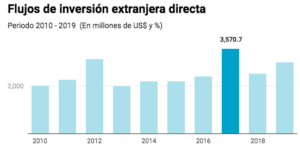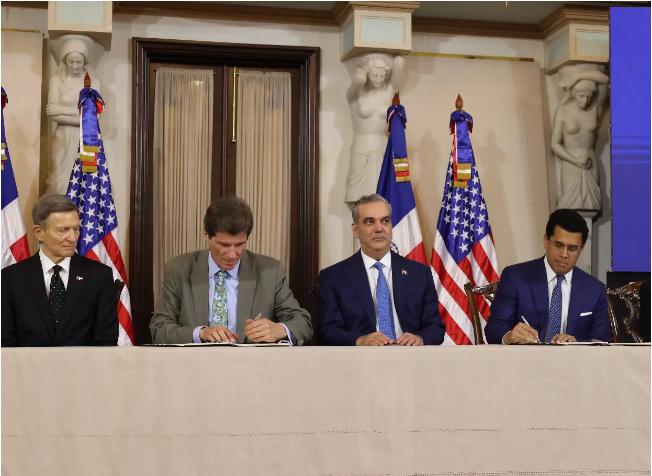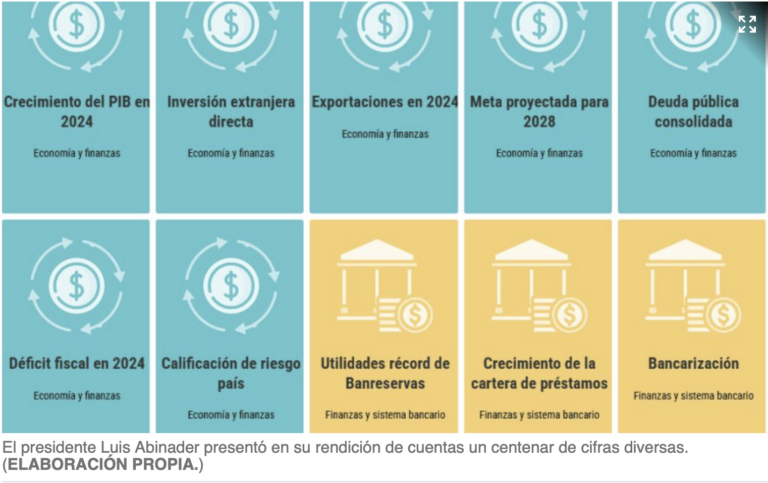La inversión extranjera directa (IED) en República Dominicana finalizó en US$3,012.0 millones al cierre de 2019, para un aumento de un 18.8% (US$477.5 millones) en comparación al año anterior, de acuerdo a datos disponibles en el Banco Central.
En el 2018 el país recibió US$2,535.3 millones, cifra menor a la del 2017, cuando fue de US$3,570.7 millones, hasta el momento la mayor cantidad registrada, la cual representó el 61% de la IED en el Caribe, que se año totalizó US$5,835 millones.
El aumento en el flujo de las IED reflejado en el año 2019, obedeció, de acuerdo al gobernador del Banco Central, Héctor Váldez Albizu, al buen clima de inversiones, estabilidad cambiaria y creación de empleos, entre otros elementos que, asegura, son relevantes para los inversionistas internacionales.
Destacó, que pese a l desafiante entorno internacional, la IED en República Dominicana ha promediado los US$2,500 millones en los últimos 10 años, recibiendo en total unos US$27,000 millones. Este monto, aseguró Alvizu, en diciembre de 2009, es superior a la recibida por las economías de Centroamérica, exceptuando Panamá.
IED por sectores y país de origen
Las estadísticas del Banco Central por país y por sector, están disponibles hasta marzo de este 2020, cuando la IED sumó US$26,130.6 millones. En el primer trimestre de este año la IED del país acumula US$758.4 millones, por lo que los efectos causados por el covid-19 a este renglón aún no está registrado en la IDE.
Mientras que, según los datos oficiales, el país de donde proviene mayor IED desde 2010 hasta marzo de 2020, fue Estados Unidos, con US$5,805.9 millones, que representa el 22.2% del total. Le sigue Canadá, con US$4,640.5 millones (17.8%); luego Brasil, con US$2,374 millones (9.1%); España, con US$1,776.2 millones (6.8%); y México, con US$1,453.1 millones (5.6%).
Respecto a las actividades económicas que recibieron la mayor IED, el comercio e industria registraron US$6,218.1 millones, es decir, el 23.8% del total. En tanto turismo, ocupa el segundo lugar, al acumular US$5,140.0 millones (19.7%). Le siguen el sector minero, con US$3,933.3 millones (15.1%); luego el inmobiliario, con US$3,847.2 millones (14.7%); y zonas francas, con US$2,068.3 millones (7.9%).
Proyecciones del 2020 poscoronavirus
Según la primera Revisión de la Política de Transformación de la Producción (PTPR) del país, una vez se alivie la crisis causada por el COVID-19, República Dominicana debería diseñar nuevas políticas económicas para optimizar su potencial y aumentar la resiliencia de su economía.
El informe, presentado en junio de 2020, fue elaborado por el Centro de Desarrollo de la Organización de Cooperación y Desarrollo Económico (OCDE), en conjunto con la Comisión Económica de las Naciones Unidas para América Latina y el Caribe (Cepal) y la Conferencia de las Naciones Unidas sobre Comercio y Desarrollo (UNCTAD).
Al respecto, el presidente de la República, Luis Abinader, aseguró en su primer discurso como jefe de Estado, que pese a la delicada situación internacional “este es el momento” de invertir en República Dominicana. Para ello, aseguró, se creará un clima favorable a la inversión, la cual garantice la seguridad jurídica, la transparencia y la celeridad en los proceso de contratación.
Agregó que ordenaría a todas las instituciones públicas acelerar “el conocimiento y decisión” de toda inversión que se encuentre paralizada y que suponga creación de empleo.
Fuente: Periódico El Dinero[:en]Foreign direct investment (FDI) in the Dominican Republic ended at US$3,012.0 million at the end of 2019, for an increase of 18.8% (US$477.5 million) compared to the previous year, according to data available from the Central Bank.
In 2018 the country received US$2,535.3 million, a figure lower than that of 2017 when it was US$3,570.7 million, so far the highest amount registered, which represented 61% of the FDI in the Caribbean, which totaled US$5,835 million.
The increase in the flow of FDI reflected in 2019, was due, according to the Governor of the Central Bank, Héctor Váldez Albizu, to the good investment climate, exchange rate stability, and job creation, among other elements that, he assures, are relevant for international investors.
He highlighted that despite the challenging international environment, FDI in the Dominican Republic has averaged US$2.5 billion in the last 10 years, receiving a total of about US $ 27 billion. This amount, Alvizu assured, in December 2009, is higher than that received by the Central American economies, except Panama.
FDI by sector and country of origin
Central Bank statistics by country and by sector are available until March 2020, when FDI amounted to US$26,130.6 million. In the first quarter of this year, the country’s FDI accumulates US$758.4 million, so the effects caused by COVID-19 in this area are not yet registered in the IDE.
While, according to official data, the country where the greatest FDI comes from 2010 to March 2020 was the United States, with US$5,805.9 million, which represents 22.2% of the total. It is followed by Canada, with US $ 4,640.5 million (17.8%); then Brazil, with US $ 2,374 million (9.1%); Spain, with US $ 1,776.2 million (6.8%); and Mexico, with US $ 1,453.1 million (5.6%).
Regarding the economic activities that received the highest FDI, commerce and industry registered US $ 6,218.1 million, that is, 23.8% of the total. Regarding tourism, it ranks second, accumulating US $ 5,140.0 million (19.7%). They are followed by the mining sector, with US $ 3,933.3 million (15.1%); then real estate, with US $ 3,847.2 million (14.7%); and free zones, with US $ 2,068.3 million (7.9%).
2020 projections post-coronavirus
According to the first Review of the country’s Production Transformation Policy (PTPR), once the crisis caused by COVID-19 is alleviated, the Dominican Republic should design new economic policies to optimize its potential and increase the resilience of its economy.
The report, presented in June 2020, was prepared by the Development Center of the Organization for Economic Cooperation and Development (OECD), in conjunction with the United Nations Economic Commission for Latin America and the Caribbean (ECLAC) and the Conference of the United Nations on Trade and Development (UNCTAD).
In this regard, the President of the Republic, Luis Abinader, assured in his first speech as head of state, that despite the delicate international situation «this is the time» to invest in the Dominican Republic. For this, he assured, a favorable investment climate will be created, which guarantees legal certainty, transparency and speed in the hiring process.
He added that he would order all public institutions to accelerate «the knowledge and decision» of any investment that is paralyzed and that implies job creation.
Source: El Dinero Newspaper[:]




